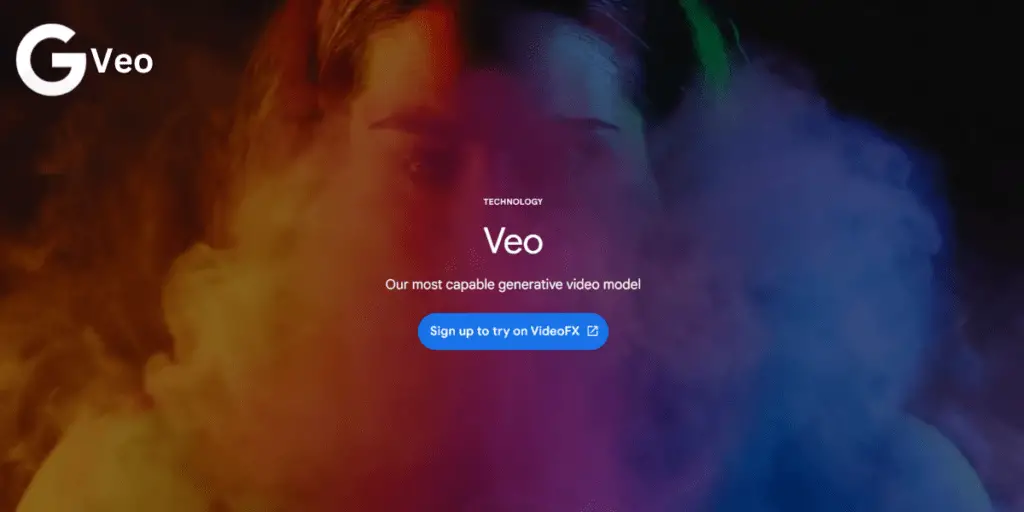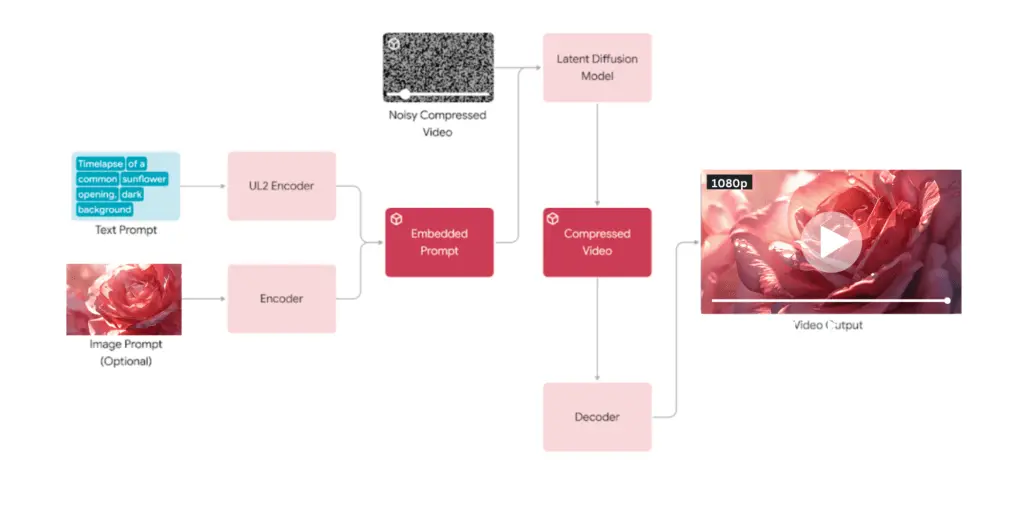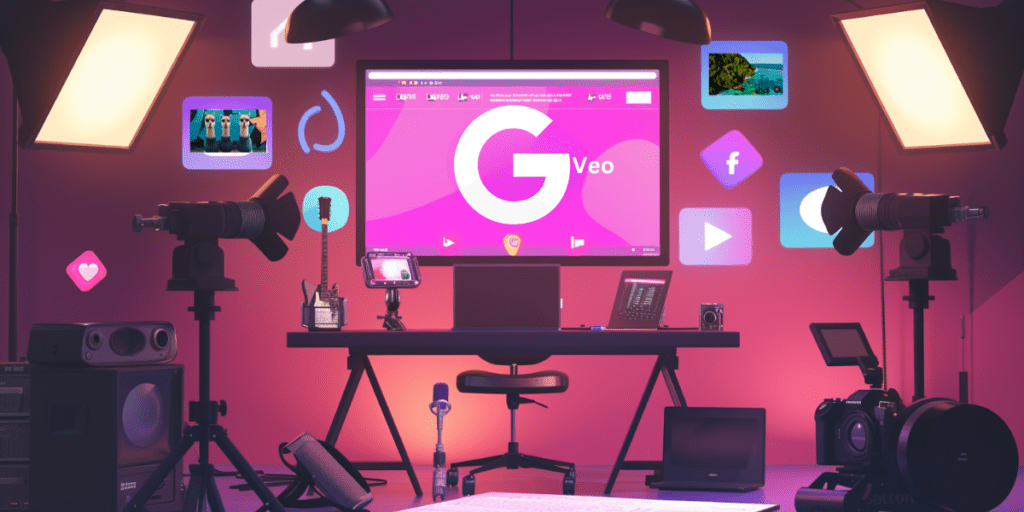At the annual Google I/O developer conference in 2024, Google launched its most advanced AI text-to-video generator to date, Google Veo Video Generator.
This tool offers high-quality video generation capabilities that promise to transform content creation across various industries.
Veo is designed to generate 1080p resolution videos that extend beyond a minute, catering to professional filmmakers and casual creators.
With its advanced understanding of natural language and ability to interpret complex cinematic terms, Veo allows users to direct and produce videos with unprecedented detail and creative control.
Google Veo Video Generator
Veo, Google’s groundbreaking text-to-video AI generator, has introduced advanced features that set it apart in digital content creation.
Veo can generate videos in 1080p resolution extending beyond one minute, pushing the boundaries of typical short-form video clips.
Users can prompt Veo to create videos in various visual and cinematic styles. For instance, Veo can render everything from serene landscapes at sunset to dynamic urban scenes under neon lights.
This capability is illustrated by prompts like a lone cowboy traversing a plain at sunset or a fast-paced tracking shot through a futuristic cityscape.
Veo’s deep understanding of natural language enables it to grasp nuanced prompts and translate them into visually rich and contextually appropriate videos. This includes understanding cinematic terms such as “timelapse,” “aerial shots,” and “film noir.”
The AI’s ability to focus on intricate details allows it to produce content that closely follows the creative vision outlined in the prompts. For example, it can generate a detailed scene of jellyfish pulsating underwater or a timelapse of the northern lights.
Veo allows users to modify videos post-generation by adding elements or changing specific areas of the footage.
This includes tasks like inserting kayaks into an aerial shot of a coastline or adjusting the ambience of a scene.

The model supports generating videos from text prompts and can also integrate image inputs to guide the visual style of the resulting video.
This dual-input capability enhances users’ creative control, enabling them to more precisely dictate their videos’ aesthetic and thematic elements.
Technical Innovations
These advancements not only enhance the quality and realism of the generated videos but also improve the efficiency and scalability of the production process.
One of the critical innovations in Veo is the use of latent diffusion transformers, a type of neural network that helps maintain the consistency and stability of visual elements across frames.
This technology reduces common video generation issues like flickering and morphing of scenes, ensuring that characters and objects appear natural and steady throughout the video.
These transformers are adept at generating detailed and high-resolution images from textual descriptions, significantly enhancing the visual quality of the videos.
By utilizing high-quality, compressed representations of video data, known as latent, Veo achieves greater efficiency in video generation.
This method allows for quicker rendering times and lower computational costs while maintaining high visual fidelity.
Compressed patents make it feasible to scale video production to longer formats without a substantial increase in resource demand, making high-quality video generation more accessible.
To further improve the model’s understanding and output, Google has enriched the training data for Veo with more detailed captions.
This enhancement helps the model grasp the nuances of complex scenes and generate videos that closely align with the user’s prompts.
The training involves various video content, enabling Veo to adeptly handle multiple themes, styles, and scenarios.
Veo is not Google’s first foray into video generation. It builds upon years of research and development in related projects like DVD-GAN, Imagen-Video, and VideoPoet.
Integrating learnings from these projects has significantly contributed to Veo’s robustness and capability.
The adoption of the Transformer architecture, renowned for its effectiveness in understanding complex patterns in data. It plays a crucial role in enabling the sophisticated interpretation of prompts and the generation of coherent video narratives.
Application
Veo is a tool for filmmakers that significantly speeds up the production process while allowing for high-level creative control.
Directors and producers can use Veo to create detailed pre-visualizations, experiment with different shots, or even produce entire segments of films.
For individuals looking to break into the world of video production, Veo lowers the technical barriers to entry.
Users can generate complex video sequences from simple text prompts, enabling them to focus on storytelling and creative expression without needing extensive resources or technical skills.
Educators can use Veo to create dynamic and engaging video content tailored to specific learning outcomes.
Whether visualizing historical events, demonstrating scientific concepts, or offering virtual tours, Veo can enrich the educational experience.
Companies and institutions can leverage Veo to produce detailed instructional videos, ranging from safety procedures to software tutorials, enhancing the clarity and effectiveness of training materials.
Marketing professionals can quickly utilize Veo to produce high-quality promotional videos. This enables rapid testing of different concepts and styles to see what best captures the audience’s attention.

Brands can craft unique stories and visually striking content that resonates with their audience, helping to build stronger emotional connections through compelling narratives.
Veo is available to select creators through a private preview inside VideoFX. Interested parties can join a waitlist, offering an exclusive opportunity to explore its capabilities before a broader rollout.
Users interact with Veo through an intuitive interface where they input textual prompts and can optionally add images. The system is designed to be user-friendly, catering to both novices and professionals.
Google has emphasized the importance of user feedback in developing Veo. Collaborations with leading creators and continuous user engagement will drive iterative improvements, enhancing the tool’s functionality and user experience.
Responsible AI Practices
Google’s Veo incorporates several measures to uphold ethical standards and mitigate potential risks associated with AI-generated content. Here’s an overview of the responsible AI practices embedded in Veo:
Veo uses a sophisticated watermarking system called SynthID to embed identifiable markers into videos.
This ensures that AI-generated videos can be easily distinguished from human-generated content. It promotes transparency, helping viewers and regulators identify and verify the origins of the content.
Veo incorporates advanced safety filters that screen input prompts and the generated video outputs to prevent the generation of harmful or inappropriate content. These filters are designed to catch and block content that could be considered unsafe or sensitive.
Veo also includes memorization-checking mechanisms to ensure that its videos do not inadvertently contain or replicate private or copyrighted material. This helps protect user privacy and intellectual property rights.

Recognizing the potential for AI systems to propagate or amplify biases, Google has implemented strategies in Veo’s development to address and reduce bias in its training datasets and algorithms.
This includes using a diverse range of data sources and continually refining the model to improve fairness and inclusivity.
The data used for training Veo is sourced responsibly, adhering to strict ethical guidelines to ensure the content is appropriate and the collection methods respect user privacy and consent.
Google collaborates with a broad spectrum of creators and stakeholders to gather feedback and insights that shape the ongoing development and refinement of Veo.
This participatory approach helps identify potential issues and ensures the technology meets diverse creative needs while adhering to ethical standards.
Veo is designed to comply with international regulations and best practices in AI ethics and governance.
Google engages with policymakers and regulatory bodies to ensure that Veo’s development and deployment align with societal norms and legal requirements.
These responsible practices are crucial for maintaining public trust and fostering a healthy ecosystem around AI-generated content.
Final Thoughts
Veo offers an unprecedented level of quality and creative control. It enables users from various fields—be it filmmaking, education, or marketing—to generate high-resolution, detailed videos from simple text prompts.
This not only democratizes video production, making it accessible to a broader audience but also opens up new avenues for creative expression and storytelling.
Introducing such powerful technology comes with its challenges, primarily concerning ethical considerations and responsible use.
Google has addressed these with robust mechanisms such as SynthID watermarking, safety filters, and memorization checks, ensuring that Veo’s capabilities are wielded with transparency and integrity.
The engagement with the creative community and adherence to regulatory standards further underlines Google’s commitment to responsible development.


